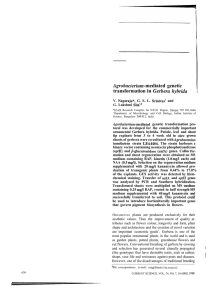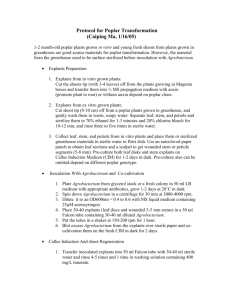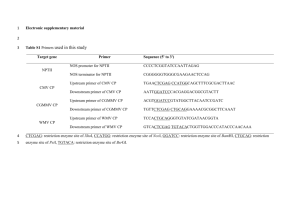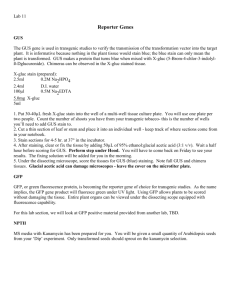Agrobacterium gaea transformation and regeneration of transgenic plants from cotyledon
advertisement
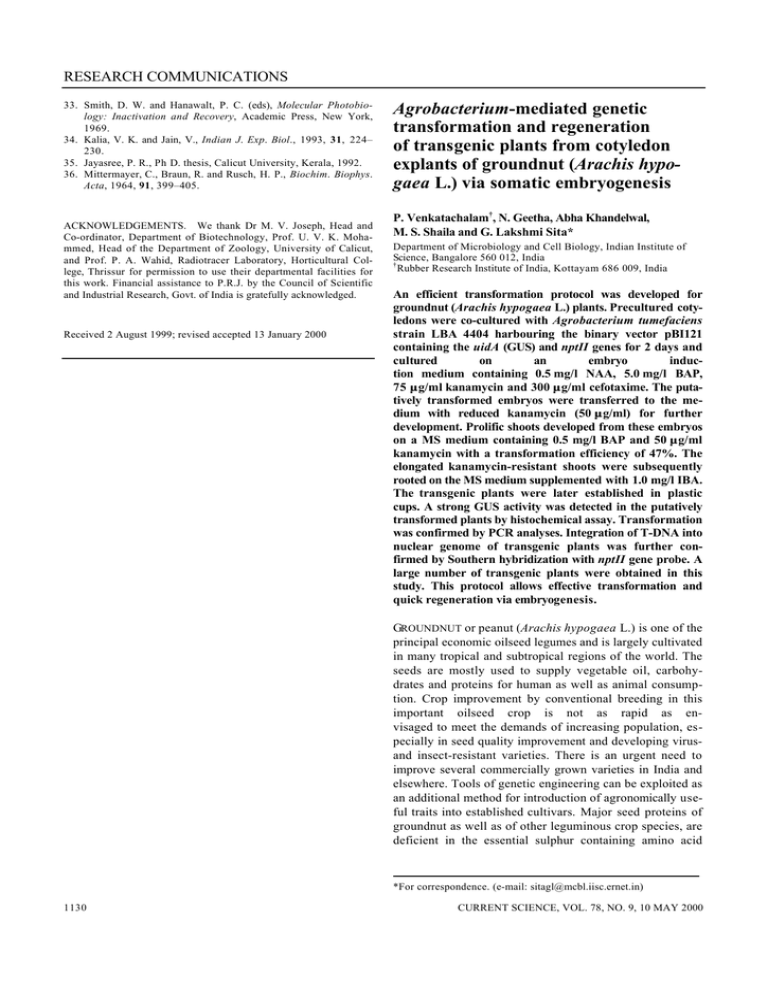
RESEARCH COMMUNICATIONS 33. Smith, D. W. and Hanawalt, P. C. (eds), Molecular Photobiology: Inactivation and Recovery, Academic Press, New York, 1969. 34. Kalia, V. K. and Jain, V., Indian J. Exp. Biol., 1993, 31, 224– 230. 35. Jayasree, P. R., Ph D. thesis, Calicut University, Kerala, 1992. 36. Mittermayer, C., Braun, R. and Rusch, H. P., Biochim. Biophys. Acta, 1964, 91, 399–405. ACKNOWLEDGEMENTS. We thank Dr M. V. Joseph, Head and Co-ordinator, Department of Biotechnology, Prof. U. V. K. Mohammed, Head of the Department of Zoology, University of Calicut, and Prof. P. A. Wahid, Radiotracer Laboratory, Horticultural College, Thrissur for permission to use their departmental facilities for this work. Financial assistance to P.R.J. by the Council of Scientific and Industrial Research, Govt. of India is gratefully acknowledged. Received 2 August 1999; revised accepted 13 January 2000 Agrobacterium-mediated genetic transformation and regeneration of transgenic plants from cotyledon explants of groundnut (Arachis hypogaea L.) via somatic embryogenesis P. Venkatachalam†, N. Geetha, Abha Khandelwal, M. S. Shaila and G. Lakshmi Sita* Department of Microbiology and Cell Biology, Indian Institute of Science, Bangalore 560 012, India † Rubber Research Institute of India, Kottayam 686 009, India An efficient transformation protocol was developed for groundnut (Arachis hypogaea L.) plants. Precultured cotyledons were co-cultured with Agrobacterium tumefaciens strain LBA 4404 harbouring the binary vector pBI121 containing the uidA (GUS) and nptII genes for 2 days and cultured on an embryo induction medium containing 0.5 mg/l NAA, 5.0 mg/l BAP, 75 µ g/ml kanamycin and 300 µ g/ml cefotaxime. The putatively transformed embryos were transferred to the medium with reduced kanamycin (50 µ g/ml) for further development. Prolific shoots developed from these embryos on a MS medium containing 0.5 mg/l BAP and 50 µ g/ml kanamycin with a transformation efficiency of 47%. The elongated kanamycin-resistant shoots were subsequently rooted on the MS medium supplemented with 1.0 mg/l IBA. The transgenic plants were later established in plastic cups. A strong GUS activity was detected in the putatively transformed plants by histochemical assay. Transformation was confirmed by PCR analyses. Integration of T-DNA into nuclear genome of transgenic plants was further confirmed by Southern hybridization with nptII gene probe. A large number of transgenic plants were obtained in this study. This protocol allows effective transformation and quick regeneration via embryogenesis. GROUNDNUT or peanut (Arachis hypogaea L.) is one of the principal economic oilseed legumes and is largely cultivated in many tropical and subtropical regions of the world. The seeds are mostly used to supply vegetable oil, carbohydrates and proteins for human as well as animal consumption. Crop improvement by conventional breeding in this important oilseed crop is not as rapid as envisaged to meet the demands of increasing population, especially in seed quality improvement and developing virusand insect-resistant varieties. There is an urgent need to improve several commercially grown varieties in India and elsewhere. Tools of genetic engineering can be exploited as an additional method for introduction of agronomically useful traits into established cultivars. Major seed proteins of groundnut as well as of other leguminous crop species, are deficient in the essential sulphur containing amino acid *For correspondence. (e-mail: sitagl@mcbl.iisc.ernet.in) 1130 CURRENT SCIENCE, VOL. 78, NO. 9, 10 MAY 2000 RESEARCH COMMUNICATIONS methionine. Efforts are already made in this direction1. There are a few reports on transformation in some varieties of groundnut with marker genes2–4 as well as one or two desirable genes like 2S albumin gene1 and Bt gene5. However, to accomplish this and other genetic engineering objectives, an efficient gene delivery to isolated tissues and the subsequent regeneration of transformed plants must still be solved for commercially important, generally recalcitrant, groundnut cultivars1. Although the transfer of foreign genes into the genome of groundnut calli was previously achieved with hypocotyl explants and other seedling explants, only a few of these reported the production of whole transgenic plants. This was mainly due to difficulties in transforming groundnut cells at sufficiently high frequencies. Although there are several approaches of developing transgenic plants, somatic embryogenesis has great potential in terms of high proliferation rates. Genetic transformation through somatic embryogenesis has not yet been reported in this oilseed crop. For successful introduction of desirable traits into the extensively cultivated varieties, efficient regeneration protocols as well as a gene delivery system need to be developed either by Agrobacterium-mediated gene transfer or the bombardment method. In this paper, we report successful transformation of groundnut by somatic embryogenesis with uidA and nptII genes. Seeds of A. hypogaea L. cv. TMV-2 were obtained from the Agricultural College and Research Station, Tamil Nadu Agricultural University, Tiruchirapalli, India. Seeds were surface disinfected with 5% Bavistin for 15 min, thoroughly washed with running tap water. Then they were sterilized with 0.1% (W/V) aqueous mercuric chloride solution for 7 min and washed with sterilized distilled water. Twenty seeds per plate were germinated aseptically in 90 × 15 mm petri dishes containing 40 ml of seed germination medium composed of the MS basal medium6 consisting of 3% (W/V) sucrose and 0.8% (W/V) agar. Seeds and all in vitro plant materials were incubated at 25 ± 2°C under a 16 h photoperiod. Light was provided by cool white fluorescent lamps with an intensity of 60 µE m– 2 –1 s . Cotyledon explants from 7-day-old seedlings were separated and used as explants for transformation experiments. Cotyledon explants were cultured on the embryo induction medium which consisted of the MS medium supplemented with 0.5 mg/l NAA and 1–10.0 mg/l BAP (MS1). LBA 4404 strain of A. tumefaciens harbouring a binary plasmid pBI121 was used as the vector system for transfor- mation. The vector map is given in Figure 1. Bacteria were maintained on LB (ref. 7) agar plates (1% W/V tryptone, 0.5% W/V yeast extract and 1% W/V sodium chloride, pH 7.0) containing 50 µg/ml kanamycin and 25 µg/ml rifampicin. For inoculation, one single colony was grown overnight on liquid LB at 28°C with appropriate antibiotics. The explants were precultured for 2 days on the embryo induction medium prior to co-cultivation with bacterial culture collected at late log phase (A600 0.6). The cotyledons (300 explants) were gently shaken in the bacterial suspension for about 10 min and blotted dry on a sterile filter paper. Afterwards, they were transferred to the medium and co-cultivated under the same condition of the preculture period (16 h photoperiod of 60 µE m–2 s –1) for 2 days at 25 ± 2°C. After co-culture, the explants were washed in the MS liquid medium, blotted dry on a sterile filter paper and transferred to the embryo induction medium (MS1) with antibiotics (75 µg/ml kanamycin and 300 µg/ml cefotaxime). Three subcultures are usually needed for the elimination of escapes. Later, the concentration of kanamycin was reduced to 50 µg/ml and completely devoid of cefotaxime. After 4 weeks, the growing embryos were excised from the primary explant and subcultured into a fresh embryo proliferation medium containing 0.5 mg/l BAP and 50 µg/ml kanamycin (MS2). The green healthy shoots from the embryos were subjected to 2–3 more passages of selection by repeated excision of buds and their exposure to selective elongation medium (MS2). Healthy and elongated shoots were rooted in the MS medium containing 1.0 mg/l IBA but without kanamycin to facilitate rooting (MS3). Untransformed embryos do not withstand more than 25 µg/ml kanamycin. All experiments were carried out in ten replicates and the experiments were repeated at least three times, keeping all the parameters unchanged. The β-glucuronidase (GUS) histochemical assay was used as a rapid way to detect the presence of the uidA gene (GUS) in the putative transformants as described by Jefferson et al.8 using leaf segments in regenerated shoots from explants. Presence of GUS and nptII was confirmed by PCR amplification of the uidA and nptII genes using two specific primer sequences. Plant DNA for PCR analysis was isolated as described by Edwards et al.9. Specific primers for gus (uidA) primer sequences (5′–3′) were TTC GCG TCG GCA TCC GCT CAG TGG CA and GCG GAC GGG TAT CCG GTT CGT TGG CA. The nptII primer sequences (5′–3′) were Figure 1. Diagrammatic representation of the pBI121 vector. The NOS-P, nopaline synthase gene promoter and NOS-T, nopaline synthase gene terminator signal control the expression of the nptII gene. CURRENT SCIENCE, VOL. 78, NO. 9, 10 MAY 2000 1131 RESEARCH COMMUNICATIONS GAG GCT ATT CGG CTA TGA CTG and ATC GGG AGG GGC GAT ACC GTA. Each PCR reaction was performed in 25 µl (total volume) of reaction mixture consisting of 10X reaction buffer, 150 ng DNA, 200 mM dNTPs, 25 mM MgCl2, 100 ng of each primer DNA and 1 unit of Taq DNA polymerase. PCR was carried out in a thermal cycler under the following conditions: 94°C for 4 min as preheating, then 35 cycles of 94°C denaturing for 1 min, 58°C annealing for 1 min and 72°C extension for 1 min and another 10 min at 72°C final extension for uidA gene detection, 94°C denaturing for 4 min as preheating, then 35 cycles of 94°C denaturing for 1 min, 55°C annealing for 1 min and 72°C synthesis for 1 min and 10 min at 72°C final extension for nptII gene detection. Amplified DNA fragments were electrophoresed on 1.2% agarose gel and detected by ethidium bromide staining, photographed under ultraviolet light. Total genomic DNA was isolated from fresh leaves of transformed and untransformed (control) plants using the CTAB (cetyltrimethylammonium bromide) method. Southern blot hybridization analysis was carried out using standard procedures7,10. Ten µg of total genomic DNA from transgenic plants and untransformed control plant was digested with HindIII. 2 µg of plasmid DNA was digested with SmaI and SacI to release the gus fragment which was used to prepare the probe. We have standardized plant regeneration in groundnut earlier by somatic embryogenesis11. After 3 weeks of culture, green multiple somatic embryos formed along the cut surface of the distal end of the cotyledons on the MS medium containing 0.5 mg/l NAA and 1–10.0 mg/l BAP. Among the various concentrations of BAP used, BAP 5.0 mg/l and NAA 0.5 mg/l (MS1) were found to be the best for maximum frequency of embryo formation (data not shown). This combination was routinely used for the transformation experiments. Each explant produced 20– 30 somatic embryos (Figure 2 a), in some instances up to 60 embryos could be seen. Early separation shows the bipolar nature of the embryos (Figure 2 b) and these germinate with proper tap root if removed early (Figure 2 c). Histological observations also confirmed the nature of the bipolar embryos. If somatic embryos are not separated from the original cotyledon explants at an early stage, they tend to develop into profuse shoots (Figure 2 d ) without root development. Embryos have to be separated for proper tap root development. However, separation of the embryos from clusters originating from the cotyledon explants was impossible without damaging the embryos as they fused with each other and to parent cotyledon explants, and have no discernible radicles. It was easier to allow the embryos to develop shoots for subsequent rooting by transferring to a medium with reduced BAP (MS2). This has been reported for groundnut12 as well as eastern redbud13 wherein multiple shoots developed from the somatic embryos. Single shoots can be excised from shoot clumps for rooting (MS3) to develop individual plants. Similar observations have been made with other legumes 1132 like Albizzia lebbeck14 and rosewood15. In general, somatic embryo morphology affects germination and plant conversion percentage in groundnut12,16. Multiple shoot formation from somatic embryos could be an alternative method of regeneration, especially if the somatic embryos are abnormal or there is a low percentage of germination. Kanamycin sensitivity of cotyledon explants was assessed prior to Agrobacterium transformation, to determine the concentration of kanamycin needed for effective growth of transgenic plants. At 50 µg/ml, kanamycin caused chlorosis and eventual necrosis in all explants by the end of the fourth week. Concentrations of 75 µg/ml and 100 µg/ml kanamycin completely inhibited embryo formation. Kanamycin concentration of 125 µg/ml and higher caused all explants to become necrotic by the third week of culture. Higher concentrations of 125 µg/ml kanamycin even killed almost all the cotyledon explants. In all previous reports of Agrobacterium-mediated transformation of groundnut, kanamycin concentration of 50–100 µg/ml was used in both the selection and regeneration medium2,3,17. In the present study, slightly higher kanamycin concentration (75 µg/ml) was used for the initial selection of transformants to prevent possible escapes. Subsequently, lower kanamycin concentration of 50 µg/ml was used to enhance the embryo proliferation. According to Pena et al.18, application of higher concentrations of the selection agent is the best way to eliminate the untransformed cells or organized tissues. One of the critical factors in achieving high frequencies of transformation in groundnut is related to preculture of explants on the embryo induction medium prior to cocultivation. Cotyledon explants were precultured for 0, 1, 2, 3, 4 and 5 days and transformation frequency was calculated by their embryo-forming ability in the selection medium (data not shown). When cotyledon explants were precultured on the regeneration medium for 2 days, the hypersensitivity response was reduced compared to cocultivation with Agrobacterium without preculture. Preculture of the explants in the regeneration medium for 2 days prior to co-cultivation was found to be optimum for efficient transformation. After selection through a two-day preculture, healthy cotyledons were infected and co-cultivated with A. tumefaciens LBA4404 harbouring pBI121 vector. During the initial two days on the non-selective embryo induction medium, all co-cultivated and control explant materials retained a healthy green colour. After transfer to the embryo induction medium with 75 µg/ml kanamycin and 300 µg/ml cefotaxime (selection medium) control explants and some of the cocultivated explants became completely necrotic within 3–4 weeks. In contrast, control cotyledon explants maintained on non-selective embryo induction medium (without kanamycin) exhibited embryogenesis (86.6%) by the end of the fourth week in culture. Embryos formed directly around the distal end of the cotyledons without intervening callus and the maximum transCURRENT SCIENCE, VOL. 78, NO. 9, 10 MAY 2000 Figure 2. Different developmental stages of groundnut transgenic plants. a, Induction of embryos; b, Single bipolar embryo; c, Plantlet derived from embryo with typical tap root; d, Regeneration and shoot formation from the transformed embryos on selection medium; e, Rooted transformed plantlet; f, Well-developed transformed plantlet established in soil; and g, Leaves from transgenic plants showing GUS activity (blue colour). RESEARCH COMMUNICATIONS formation frequency was 47% (Table 1). The embryos were maintained by regular subculturing on the MS1 medium at 3-week intervals. After 3 passages on the MS1 medium, explants with somatic embryos were subcultured onto the MS2 medium for proliferation of shoots. On the other hand, controls did not require more than 4–6 weeks for transfer into the MS2 medium for proliferation. After prolonged culture period on the same medium, multiple shoots were regenerated from embryos on the MS2 medium (Figure 2 d ). Similar results were also reported in eggplant19. Shoots developed from an individual embryo were sliced and subcultured on the MS medium with a low CURRENT SCIENCE, VOL. 78, NO. 9, 10 MAY 2000 level of BAP (0.2 mg/l) containing 50 µg/ml kanamycin for proliferation. The kanamycin concentration was lowered to 50 µg/ml at the third subculture to reduce antibiotic stress on the developing shoot buds. They were multiplied in vitro in the presence of kanamycin. Most of the transgenic clones appeared morphologically normal in comparison with the untransformed plants. The putative transformed shoots which attained 2–3 cm in length were excised and then transferred for rooting to the MS3 medium (Figure 2 e). Fifty plants were selected and these were transferred to the soil. Figure 2 f shows the well- established transgenic plant. The survival rate was 90–95%. 1133 RESEARCH COMMUNICATIONS The transformation efficiency obtained in this study is as high as that reported earlier using groundnut leaf tissue2,3. Eapen and George2 observed an average of 6.7% of shoot regeneration on the selection medium containing 50 µg/ml kanamycin. Cheng et al.3 reported that the frequency of transformed fertile plants was 0.2 to 0.3% of the leaf explants inoculated. In the previous reports, transformation efficiency was low, as the explants were co-cultivated without preculturing. In the present study, an important factor which enhanced the transformation efficiency of groundnut was the 2-day preculture of the explants, which probably served to reduce wound stress and increased the number of competent cells at the wound site. A similar result was also reported in other species by Akama et al.20 and Muthukumar et al.21. The results indicated that the efficiency of shoot regeneration was dependent on the explant type. Recent success in the production of transgenic plants using Agrobacterium in cowpea21 and chickpea22 was based on explants like hypocotyls, epicotyls and cotyledons. These results suggest that under the experimental conditions used in the present study cells of cotyledons may havecomeence or ‘shoot induction signals’ and that the competence may viously by Eapen and George2 and Cheng et al.3 in groundnut. Presence of the uidA and nptII genes in the plant genome was confirmed by PCR analysis with specific primers using DNA from leaves. PCR analysis revealed that 0.53 kb uidA and 0.8 kb nptII DNA fragments amplified from genomic DNA of all putative transgenic plants. However, no uidA and nptII PCR products were seen for untransformed control plants. Figure 3 a shows that all the samples of transgenic plants (lanes 4–9) gave the predicted size of DNA fragment of 0.53 kb of uidA gene. No band was detected in the DNA sample from an untransformed control plant (lane 3). The 0.53 kb DNA fragment was also amplified from the pBI121 plasmid as positive control (lane 2). DNA products with the expected size of 0.8 kb were amplified from total genomic DNAs of the putative transgenic plants (Figure 3 b, lanes 5–11). These DNA fragments were not Table 1. Transformation frequency of putatively transformed embryos from groundnut cotyledon explants on MS medium containing NAA (0.5 mg/l), BAP (5.0 mg/l), kanamycin (75 µg/ml) and cefotaxime (300 µg/ml) Experiment Control* Control** Expt. 1 Expt. 2 Expt. 3 Expt. 4 Expt. 5 No. of explants co-cultured No. of explants responded Frequency of embryos Average no. of embryos/ cotyledon 75 86 45 36 51 39 40 65 0 17 15 24 17 15 86.6±4.3 00.0±0.0 37.7±2.6 41.6±3.8 47.0±4.2 43.5±3.6 37.5±3.3 65.0±3.7 00.0±0.0 52.0±3.4 48.0±3.1 56.0±4.7 32.0±2.8 41.0±3.9 *No co-cultivation, non-selective medium (without kanamycin). **No co-cultivation, selection medium (with 75 µg/ml of kanamycin). vary in different groundnut explants. The regenerated embryos or leaves were subjected to in situ GUS assay. The expression of uidA gene was verified by histochemical staining of the leaf of the transgenic plants. The nptII positive regenerants showed the typical indigo blue colouration of X-Gluc treatment, while the negative ones did not. Also, more than 45% of the regenerants were GUS positives. Young leaves were more densely stained than other tissue of the plant (Figure 2 g). This seems to be a typical expression pattern of the CaMV 35S promoter regulated uidA gene in young tissues 8. Leaf tissues from untransformed plants did not show GUS activity. These results and the extensive GUS expression in tissues, clearly demonstrate the stability of the inserted genes in the transformed plants. GUS expression was also reported pre1134 Figure 3. PCR analysis of transgenic shoots by amplication of the uidA (GUS) and nptII genes from total plant DNA extracts. a, Detection of the uidA (GUS) gene. Lane 1, DNA size marker; lane 2, Plasmid PBI121 (positive control); lane 3, Untransformed plant (negative control); lanes 4–9, Transformed plants; and b, Detection of the nptII gene. Lane 1, DNA size marker; lanes 2, 4, Untransformed plants (negative control); lane 3, Plasmid pBI121 (positive control); lanes 5–11, Transformed plants. CURRENT SCIENCE, VOL. 78, NO. 9, 10 MAY 2000 RESEARCH COMMUNICATIONS Figure 4. Southern blot analysis of transgenic groundnut plants previously identified by PCR analysis. Total genomic DNA (10 µg) digested with HindII was hybridized with random primed α32P labelled GUS probes. Lane M, Labelled DNA size marker; lanes 1–10, Genomic DNA from independent lines of transformed plants. detected in the untransformed control plant (Figure 3 b, lanes 2, 4). As a positive control, the nptII gene products were also amplified from the pBI121 plasmid (Figure 3 b Lane 3). Based on the resistance to kanamycin and PCR detection, presence of both uidA and nptII genes was confirmed in the transgenic groundnut plants. In the previous reports on transgenic groundnut plants obtained by microprojectile bombardment1,23 and Agrobacterium-mediated transformation2,24,25 foreign gene products were not analysed by the PCR method. The integration of the gus reporter gene into the transformed plant genomic DNA was further confirmed by Southern blot hybridization analysis. The genomic DNA from randomly selected GUS positive transgenics and one untransformed control plant was digested with HindIII which cuts at only one site located between the uidA (GUS) and nptII genes in the T-DNA insert of pBI121 plasmid. The gus gene was used as a probe. The gus DNA probe hybridized to DNA from transgenic plants (Figure 4) showed integration at different positions ranging from 2.5 kb to 23 kb. Few lines have shown single integration (lanes 1–4) and others have shown multiple integration (lanes 5–10). The DNA from the untransformed control plant did not show any signal (data not shown); the result indicated that the gus gene was integrated into the groundnut genome. A similar type of multiple copies of gene integration with the groundnut genome was reported by Ozias-Akins et al.26 and Cheng et al.3. With the exception of the report by McKently et al.17, transformation frequencies for groundnut appear to be substantially lower in other reports of transformation. In this study protocol modification in the form of kanamycin concentration and preculture treatment substantially enhanced the transformation efficiency in groundnut and may be a major reason for the higher frequency obtained in this study CURRENT SCIENCE, VOL. 78, NO. 9, 10 MAY 2000 compared to the other reports on Agrobacterium-mediated transformation of this species. The results presented also demonstrate a simple and highly efficient system for producing peanut somatic embryos from cotyledon explants. The system does not require maintenance of embryogenic callus or apical meristem excision as in most previous procedures on genetic transformation of peanut, which are labour-intensive techniques. Moreover, in many cases the use of these explant materials results in the production of sterile plants and/or somaclonal variants. In the present study fertile plants were obtained. In addition, transformation was done via Agrobacterium and not by particle bombardment as was done in most of the previous reports which is an expensive method compared to Agrobacterium-mediated transformation. The protocol can be used efficiently for the introduction of more desirable genes and is currently being used for producing transgenic plants with desirable genes. 1. Lacorte, C., Aragao, F. J. L., Almeida, E. R., Mansur, E. A. and Rech, E. L., Plant Cell Rep., 1997, 16, 619–623. 2. Eapen, S. and George, L., Plant Cell Rep., 1994, 13, 582–586. 3. Cheng, M., Jarret, R. L., Li, Z., Xing, A. and Demski, J. W., Plant Cell Rep., 1996, 15, 653–657. 4. Wang, A., Hanli, F., Singsit, C. and Ozias-Akins, P., Physiol. Plant., 1998, 102, 38–48. 5. Singsit, C., Adang, M. J., Lynch, R. E., Anderson, W. F., Wang, A., Cardineau, G. and Ozias-Akins, P., Transgenic Res., 1997, 6, 169–176. 6. Murashige, T. and Skoog, F., Physiol. Plant., 1962, 15, 473– 497. 7. Sambrook, J., Fritsch, E. F. and Maniatis, T., Molecular Cloning: A Laboratory Manual, Cold Spring Harbor Laboratory Press, 1989, Second edn. 8. Jefferson, R. A., Kavanagh, T. A. and Bevan, M. W., EMBO J., 1987, 6, 3901–3907. 9. Edwards, K., Johnstone, C. and Thompson, C. C., Nucleic Acids Res., 1991, 19, 1349. 10. Ben-Meir and Vainstein, A., Sci. Hortic., 1994, 58, 115–121. 11. Venkatachalam, P., Geetha N., Abha Khandelwal, Shaila, M. S. and Lakshmi Sita, G., Curr. Sci., 1999, 77, 269–273. 12. Chengalrayan, K., Mhaske, V. B. and Hazra, S., Plant Cell Rep., 1997, 16, 783–786. 13. Distabanjong, K. and Geneve, R. L., Plant Cell Rep., 1997, 16, 334–338. 14. Gharyal, P. K. and Maheshwari, S. C., Naturwissenschaften, 1981, 68, 379–380. 15. Rao, M. M. and Lakshmi Sita, G., Plant Cell Rep., 1996, 15, 355–359. 16. Wetzstein, H. Y. and Baker, C. M., Plant Sci., 1993, 92, 81–89. 17. McKently, A. H., Moore, G. A., Doostdar, H. and Niedz, R. P., Plant Cell Rep., 1995, 14, 699–703 18. Pena, L., Cervera, M., Juarez, J., Navarro, A., Pina, J. A. and Navarro, L., Plant Cell Rep., 1997, 16, 731–737. 19. Fari, M., Nagy, I., Csanyi, M., Mityko, J. and Andrasfalvy, A., Plant Cell Rep., 1995, 15, 82–86. 20. Akama, K., Shiraishi, H., Ohta, S., Nakamura, K., Okada, K. and Shimura, Y., Plant Cell Rep., 1992, 12, 7–11. 21. Muthukumar, B., Mariamma, M., Veluthambi, K. and Gnanam, A., Plant Cell Rep., 1996, 15, 980–985. 22. Kar, S., Johnson, T. M., Nayak, P. and Sen, S. K., Plant Cell Rep., 1996, 16, 32–37. 1135 RESEARCH COMMUNICATIONS 23. Schnall, J. A. and Weissinger, A. K., Plant Cell Rep., 1993, 12, 316–319. 24. Mansur, E. A., Lacorte, C., deFreitas, V. G., deOliveria, D. E., Timmerman, B. and Cordeiro, A. R., Plant Sci., 1993, 89, 93– 99. 25. Lacorte, C., Mansur, E. A., Timmerman, B. and Cordeiro, A. R., Plant Cell Rep., 1991, 10, 354–357. 26. Ozias-Akins, P., Schnall, J. A., Anderson, W. F., Singsit, C., Clemente, T. E., Adang, M. J. and Weissinger, A. K., Plant Sci., 1993, 93, 185–194. ACKNOWLEDGEMENT. P. V. is grateful to Department of Biotechnology DBT, Govt. of India, New Delhi for the financial assistance in the form of post-doctoral fellowship. Received 14 October 1999; revised accepted 29 February 2000 Blinding induces copulatory activity among inactive males of South Indian gerbils Biju B. Thomas and Mathew M. Oommen* Department of Zoology, University of Kerala, Kariavattom, Thiruvananthapuram 695 581, India The effect of blinding on reproductive behavioural physiology of male South Indian gerbils (Tatera indica cuvieri) was assessed. Blinding of reproductively inactive adult males resulted in 60% of them exhibiting sexual activity. Reproductive behavioural variables studied, such as intromission frequency, thrust frequency, ejaculation frequency and postejaculatory copulation frequency were exhibited to the level of reproductively active males. Such reproductive activation was also reflected in the epididymal sperm count. These studies reveal that blinding (constant darkness) may have a stimulatory effect in the reproduction of the tropical rodent T. indica cuvieri. A MONG mammals, photoperiodic cues determine the periods of sexual activity and inactivity especially in temperate species1,2. Several investigations have been carried out to establish the influence of photoperiodic changes on reproduction. In hamsters, exposure to short photoperiod resulted in gonadal regression and loss of sexual behaviour3,4. Constant darkness (blinding) also influences reproduction of male rodents. According to Hard and Larsson 5, though mating was not fully impaired, the intervals between ejaculations were shorter for blinded male laboratory rats. In laboratory rats whose visual function was destroyed neonatally, a deficit in copulatory behavioural variables coupled with a decreased androgen level were observed6. Lack of responsiveness of the reproductive sys- tem to photoperiodic changes has been reported for male laboratory rats7 and prairie voles8. Among tropical rodents gonadal regression consequent to short photoperiod has been reported for Indian palm squirrel Funambulus pennanti 9. Another tropical rodent, the cane mouse (Zygodontomys brevicauda), however, was not responsive to variation in photoperiod with regard to the weight of testis and seminal vesicle10. Sinhasane and Joshi11 reported that in Indian desert gerbil, Meriones hurrianae, constant light resulted in reproductive inhibition whereas constant darkness was stimulatory. The South Indian gerbil Tatera indica cuvieri is a burrow dwelling tropical rodent with adult males and females occupying separate closed burrows12. They were found to be breeding throughout the year13. Our field observations show that the animal is nocturnal with foraging habits during the night after the onset of darkness. The male reproductive behaviour pattern of this rodent has been described14. The mating pattern consists of a courtship fighting (upright boxing), several mountings by the male, and intromissions. Ejaculation takes place during one of the intromissions. Typically a male exhibits one to four ejaculations during a complete mating period, and following the final ejaculation the male continued the copulatory activity without any ejaculation. However about 50% of the males were found to be reproductively inactive and did not exhibit these mating sequences15. Though photoperiodic alterations do influence the reproductive phenomenon of rodents, the response depends on the experimental schedule and the species employed. Hence further investigations on the male reproductive mechanism of this rodent is worth undertaking. As a first step we carried out the present study by assessing the impact of blinding on the reproduction of adult reproductively inactive male gerbils. Gerbils were collected regularly from the field throughout the year, brought and acclimatized to the laboratory conditions under light/dark cycle of 12 : 12 h. Adult animals (165– 185 g) were selected from among a stock of healthy ones. Only those males (n = 8) which did not copulate in several mating tests (range 4–6) were employed for blinding experiments. These reproductively inactive males did not show any mating behaviour other than random mounting attempts. Animals were housed individually in polypropylene cages provided with bedding of wood shavings and paper bits. They were maintained on laboratory rat feed and water ad libitum. Blinding (constant darkness) was effected according to the method described by Thomas and Oommen16. For this, 0.2–0.3 ml of absolute alcohol (Merck, Germany) was administered into the vitreous chamber of the eye under mild etherization. This volume ensured a rapid and uniform distribution of the alcohol within the vitreous chamber under a pressure, with the excess flowing out. Following this the iris turned white, and an antiseptic eye ointment was applied to prevent any possible infection. *For correspondence. 1136 CURRENT SCIENCE, VOL. 78, NO. 9, 10 MAY 2000
